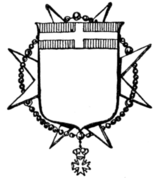confusion, for the officers of the College of Arms, when speaking officially, decline to admit the insignia of the order in any official emblazonment of arms. Lyon King of Arms has been less punctilious.
Knights of Justice, Knights of Grace, and Esquires of the Orders all suspend the badges they wear from a black watered-silk ribbon below their shields (Fig. 334), and Ladies of Justice and Ladies of Grace do the same below their lozenges. The arms of members of the Order are frequently depicted superimposed upon the Cross. By the Statutes of the Order Knights of Justice were required to show that all their four grandparents were legally entitled to bear arms, but so many provisions for the exercise of discretion in dispensing with this requirement were at the same time created that to all intents and purposes such a regulation might never have been included. Some of the Knights of Justice even yet have no arms at all, others are themselves grantees, and still others would be unable to show what is required of them if the claims of their grandparents were properly investigated.
It should perhaps be stated that supporters, when granted to Knights Grand Cross as such, are personal to themselves, and in the patents by which they are granted the grant is made for life only, no hereditary limitation being added.
Any person in this country holding a Royal Licence to wear the insignia of any foreign order is permitted to adopt any heraldic form, decoration, or display which that order confers in the country of origin. Official recognition exists for this, and many precedents can be quoted.

Fig. 772.—"Bailli-profès" of the Catholic Order of the Knights Hospitallers or the Order of Malta.
The rules which exist in foreign countries concerning heraldic privileges of the knights of different orders are very varied, and it is impossible to briefly summarise them. It may, however, be stated that the most usual practice is to display the shield alone in the centre of the star (Fig. 772). As with us, the collars of the orders are placed around the shields, and the badges depend below, but the use of the circlet carrying the motto of the order is exclusively a British practice. In the case of some of the Orders, however, the official coat of arms of the order is quartered, impaled, or borne in pretence with the personal arms, and the cross patée of the Order of the Dannebrog is to be met with placed in front of a shield of quarterings, the charges thereupon appearing in the angles of the cross. I am not sure, however, that the cases which have come under my notice should not be rather considered

